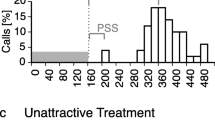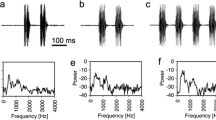Abstract
Male–male vocal competition in anuran species is critical for mating success; however, it is also highly time-consuming, energetically demanding and likely to increase predation risks. Thus, we hypothesized that changes in the social context would cause male vocal competition to change in real time in order to minimize the costs and maximize the benefits of competition. To test this hypothesis, we assessed the effect of repeating playbacks of either white noise (WN) or male advertisement calls on male call production in the Emei music frog (Babina daunchina), a species in which males build mud-retuse burrows and call from within these nests. Previous studies have shown that calls produced from inside burrows are highly sexually attractive (HSA) to females while those produced outside nests are of low sexual attractiveness (LSA). Results showed that most subjects called responsively after the end of WN playbacks but before the onset of conspecific call stimuli although call numbers were similar, indicating that while males adjusted competitive patterns according to the biological significance of signals, their competitive motivation did not change. Furthermore, these data indicate that the frogs had evolved the ability of interval timing. Moreover, when the inter-stimulus interval (ISI) between playbacks was varied, the subjects preferentially competed with HSA calls when the ISI was short (<4 s) but responded equally to HSA and LSA calls if the ISI was long (≥4 s), suggesting that males allocate competitive efforts depending on both the perceived sexual attractiveness of rivals and the time available for calling. Notably, approximately two-thirds of male calls occurred in response to HSA calls, a preference rate comparable to that previously found for females in phonotaxis experiments and consistent with the idea that the mechanisms underlying both the male’s competitive responses to rivals and the female’s preferences toward potential mates coevolved under the same selective pressure.



Similar content being viewed by others
References
Akre KL, Ryan MJ (2010) Complexity increases working memory for mating signals. Curr Biol 20(6):502–505. doi:10.1016/j.cub.2010.01.021
Amy M, Monbureau M, Durand C, Gomez D, Théry M, Leboucher G (2008) Female canary mate preferences: differential use of information from two types of male–male interaction. Anim Behav 76(3):971–982. doi:10.1016/j.anbehav.2008.03.023
Arak A (1983) Sexual selection by male–male competition in natterjack toad choruses. Nature 306(5940):261–262. doi:10.1038/306261a0
Baddeley A (2010) Working memory. Curr Biol 20(4):R136–R140. doi:10.1016/j.cub.2009.12.014
Baddeley A, Hitch G (1974) Working memory. In: GA B (ed) Recent advances in learning and motivation, vol 8. Academic Press, New York, pp 47–89
Bergmüller R, Taborsky M (2010) Animal personality due to social niche specialisation. Trends Ecol Evol 25(9):504–511. doi:10.1016/j.tree.2010.06.012
Brockmann HJ (2001) The evolution of alternative strategies and tactics. Adv Study Behav 30:1–51. doi:10.1016/S0065-3454(01)80004-8
Byrne PG (2008) Strategic male calling behavior in an Australian terrestrial toadlet (Pseudophryne bibronii). Copeia 2008(1):57–63. doi:10.1643/CE-05-294
Cheng K, Crystal J (2008) Learning to time intervals. In: Menzel R (ed) Learning theory and behavior: a comprehensive reference, vol 1. Academic Press, Oxford, pp 341–364
Cohen J (1992) A power primer. Psychol Bull 112(1):155–159. doi:10.1037//0033-2909.112.1.155
Contreras-Garduño J, Osorno JL, Córdoba-Aguilar A (2007) Male-male competition and female behavior as determinants of male mating success in the semi-terrestrial hermit crab Coenobita compressus (H. Milne Edwards). J Crust Biol 27(3):411–416. doi:10.1651/S-2684.1
Cotton S, Small J, Pomiankowski A (2006) Sexual selection and condition-dependent mate preferences. Curr Biol 16(17):R755–R765. doi:10.1016/j.cub.2006.08.022
Cox CR, Le Boeuf BJ (1977) Female incitation of male competition: a mechanism in sexual selection. Am Nat 111(978):317–335
Crystal JD (2006) Animal behavior: timing in the wild. Curr Biol 16(7):R252–R253. doi:10.1016/j.cub.2006.03.001
Crystal JD, Baramidze GT (2007) Endogenous oscillations in short-interval timing. Behav Processes 74(2):152–158. doi:10.1016/j.beproc.2006.10.008
Cui JG, Wang YS, Brauth SE, Tang YZ (2010) A novel female call incites male-female interaction and male–male competition in the Emei music frog, Babina daunchina. Anim Behav 80:181–187. doi:10.1016/j.anbehav.2010.05.012
Cui JG, Song XY, Fang GZ, Xu F, Brauth SE, Tang YZ (2011) Circadian rhythm of calling behavior in the Emei music frog (Babina daunchina) is associated with habitat temperature and relative humidity. Asian Herpetol Res 2(3):149–154. doi:10.3724/SP.J.1245.2011.00149
Cui JG, Tang YZ, Narins PM (2012) Real estate ads in Emei music frog vocalizations: female preference for calls emanating from burrows. Biol Lett 8(3):337–340. doi:10.1098/rsbl.2011.1091
Dyson ML, Passmore NI (1988) The combined effect of intensity and the temporal relationship of stimuli on phonotaxis in female painted reed frogs Hyperolius marmoratus. Anim Behav 36(5):1555–1556. doi:10.1016/S0003-3472(88)80232-X
Fang GZ, Yang P, Cui JG, Yao DZ, Brauth SE, Tang YZ (2012) Mating signals indicating sexual receptiveness induce unique spatio-temporal EEG theta patterns in an anuran species. PLoS ONE 7(12):e52364. doi:10.1371/journal.pone.0052364
Freeberg TM, Lucas JR (2009) Pseudoreplication is (still) a problem. J Comp Psychol 123(4):450–451. doi:10.1037/a0017031
Gerhardt HC, Huber F (2002) Acoustic communication in insects and anurans: common problems and diverse solutions. University of Chicago Press, Chicago
Grafe TU (1997) Costs and benefits of mate choice in the lek-breeding reed frog Hyperolius marmoratus. Anim Behav 53(5):1103–1117. doi:10.1006/anbe.1996.0427
Grafe TU (1999) A function of synchronous chorusing and a novel female preference shift in an anuran. Proc R Soc Lond B Biol Sci 266(1435):2331–2336. doi:10.1098/rspb.1999.0927
Grafe TU (2005) Anuran choruses as communication networks. In: McGregor PK (ed) Animal communication networks. Cambridge University Press, Cambridge, pp 277–299
Greenfield MD (2002) Signalers and receivers: mechanisms and evolution of arthropod communication. Oxford University Press, Oxford
Greenfield MD (2005) Mechanisms and evolution of communal sexual displays in arthropods and anurans. Adv Study Behav 35:1–62. doi:10.1016/S0065-3454(05)35001-7
Gross MR (1996) Alternative reproductive strategies and tactics: diversity within sexes. Trends Ecol Evol 11(2):92–98. doi:10.1016/0169-5347(96)81050-0
Howard RD, Palmer JG (1995) Female choice in Bufo americanus: effects of dominant frequency and call order. Copeia 1:212–217
Hurlbert SH (1984) Pseudoreplication and the design of ecological field experiments. Ecol Monogr 54(2):187–211. doi:10.2307/1942661
Hurlbert SH (2004) On misinterpretations of pseudoreplication and related matters: a reply to Oksanen. Oikos 104(3):591–597. doi:10.1111/j.0030-1299.2004.12752.x
Klump GM, Gerhardt HC (1992) Mechanisms and function of call-timing in male–male interactions in frogs. In: McGregor P (ed) Playback and studies of animal communication. Plenum, New York, pp 153–174
Kroodsma DE, Byers BE, Goodale E, Johnson S, Liu W-C (2001) Pseudoreplication in playback experiments, revisited a decade later. Anim Behav 61(5):1029–1033. doi:10.1006/anbe.2000.1676
Lee DK, Itti L, Koch C, Braun J (1999) Attention activates winner-take-all competition among visual filters. Nat Neurosci 2:375–381. doi:10.1038/7286
Leonard AS, Hedrick AV (2009) Male and female crickets use different decision rules in response to mating signals. Behav Ecol 20(6):1175–1184. doi:10.1093/beheco/arp115
Litovsky RY, Colburn HS, Yost WA, Guzman SJ (1999) The precedence effect. J Acoust Soc Am 106:1633–1654. doi:10.1121/1.427914
Loftus-Hills JJ (1973) Neural mechanisms underlying acoustic behaviour of the frog, Pseudophryne semimarmorata (Anura: Leptodactylidae). Anim Behav 21(4):781–787. doi:10.1016/S0003-3472(73)80104-6
Loftus-Hills JJ (1974) Analysis of an acoustic pacemaker in Strecker’s chorus frog, Pseudacris streckeri (Anura: Hylidae). J Comp Physiol 90(1):75–87. doi:10.1007/BF00698369
Martínez-Rivera CC, Gerhardt HC (2008) Advertisement-call modification, male competition, and female preference in the bird-voiced treefrog Hyla avivoca. Behav Ecol Sociobiol 63(2):195–208. doi:10.1007/s00265-008-0650-0
McGregor PK (2000) Playback experiments: design and analysis. Acta ethologica 3(1):3–8. doi:10.1007/s102110000023
McGregor P, Catchpole C, Dabelsteen T, Falls J, Fusani L, Gerhardt H, Gilbert F, Horn A, Klump G, Kroodsma D (1992) Design of playback experiments: the Thornbridge Hall NATO ARW consensus. Playback and studies of animal communication. Plenum Press, New York
Munro BH (2005) Statistical methods for health care research, vol 1. Lippincott Williams & Wilkins, Philadelphia
Naguib M (1999) Effects of song overlapping and alternating on nocturnally singing nightingales. Anim Behav 58(5):1061–1067. doi:10.1006/anbe.1999.1223
Naguib M (2005) Singing interactions in songbirds: implications for social relations and territorial settlement. In: McGregor PK (ed) Animal communication networks. Cambridge University Press, Cambridge, pp 300–319
Oksanen L (2001) Logic of experiments in ecology: is pseudoreplication a pseudoissue? Oikos 94(1):27–38. doi:10.1034/j.1600-0706.2001.11311.x
Oksanen L (2004) The devil lies in details: reply to Stuart Hurlbert. Oikos 104(3):598–605. doi:10.1111/j.0030-1299.2004.13266.x
Patricelli GL, Uy JAC, Walsh G, Borgia G (2002) Sexual selection: male displays adjusted to female’s response. Nature 415(6869):279–280. doi:10.1038/415279a
Price AC, Helen Rodd F (2006) The effect of social environment on male–male competition in guppies (Poecilia reticulata). Ethology 112(1):22–32. doi:10.1111/j.1439-0310.2006.01142.x
Rémy A, Grégoire A, Perret P, Doutrelant C (2010) Mediating male–male interactions: the role of the UV blue crest coloration in blue tits. Behav Ecol Sociobiol 64(11):1839–1847. doi:10.1007/s00265-010-0995-z
Sauseng P, Klimesch W, Gruber WR, Birbaumer N (2008) Cross-frequency phase synchronization: a brain mechanism of memory matching and attention. Neuroimage 40(1):308–317. doi:10.1016/j.neuroimage.2007.11.032
Sauseng P, Griesmayr B, Freunberger R, Klimesch W (2010) Control mechanisms in working memory: a possible function of EEG theta oscillations. Neurosci Biobehav Rev 34(7):1015–1022. doi:10.1016/j.neubiorev.2009.12.006
Schank JC, Koehnle TJ (2009) Pseudoreplication is a pseudoproblem. J Comp Psychol 123(4):421–433. doi:10.1037/a0013579
Schwartz JJ (1987) The function of call alternation in anuran amphibians: a test of three hypotheses. Evolution 41:461–471. doi:10.2307/2409249
Schwartz JJ, Buchanan BW, Gerhardt HC (2001) Female mate choice in the gray treefrog (Hyla versicolor) in three experimental environments. Behav Ecol Sociobiol 49(6):443–455. doi:10.1007/s002650100317
Searcy WA, Nowicki S, Hughes M (1997) The response of male and female song sparrows to geographic variation in song. Condor: 651–657. doi:10.2307/1370477
Shen JX, Feng AS, Xu ZM, Yu ZL, Arch VS, Yu XJ, Narins PM (2008) Ultrasonic frogs show hyperacute phonotaxis to female courtship calls. Nature 453(7197):914–916. doi:10.1038/nature06719
Trivers R (1972) Parental investment and sexual selection. In: Campbell B (ed) Sexual selection and the descent of man. Aldine Press, Chicago, pp 136–179
Wang XJ (2002) Probabilistic decision making by slow reverberation in cortical circuits. Neuron 36(5):955–968. doi:10.1016/S0896-6273(02)01092-9
Wang XJ (2008) Decision making in recurrent neuronal circuits. Neuron 60(2):215–234. doi:10.1016/j.neuron.2008.09.034
Wells KD (2007) The ecology and behavior of amphibians. University of Chicago Press, Chicago
Wells K, Schwartz J (2006) The behavioral ecology of anuran communication. In: Narins PM, Feng AS, Fay RR, Popper AN (eds) Hearing and sound communication in amphibians. Springer Verlag, New York, pp 44–86
Wiley RH, Poston J (1996) Perspective: indirect mate choice, competition for mates, and coevolution of the sexes. Evolution: 1371–1381. doi:10.2307/2410875
Williams GC (1996) Adaptation and natural selection: a critique of some current evolutionary thought. Princeton University Press, Princeton
Wong KF, Huk AC, Shadlen MN, Wang XJ (2007) Neural circuit dynamics underlying accumulation of time-varying evidence during perceptual decision making. Front comput neurosci 1:1–11. doi:10.3389/neuro.10.006.2007
Xu F, Cui JG, Song J, Brauth SE, Tang YZ (2012) Male competition strategies change when information concerning female receptivity is available. Behav Ecol 23(2):307–312. doi:10.1093/beheco/arr187
Zelick RD, Narins PM (1982) Analysis of acoustically evoked call suppression behaviour in a neotropical treefrog. Anim Behav 30(3):728–733. doi:10.1016/S0003-3472(82)80144-9
Zurek PM (1987) The precedence effect. In: Yost WA, Gourevitch G (eds) Directional hearing. Springer-Verlag, New York, pp 85–105
Acknowledgments
This work was supported by the grants from the National Natural Science Foundation of China (No. 31372217 to Guangzhan Fang and No. 31270042 to Jianguo Cui), from the “Hundred Talents Program” of Chinese Academy of Sciences (KSCX2-YW-R-077) to Yezhong Tang and from the Youth Professor Project of Chengdu Institute of Biology (Y3B3011) and Youth Innovation Promotion Association of Chinese Academy of Sciences (Y2C3011, KSCX2-EW-J-22) to Jianguo Cui.
Conflict of interest
The authors declare that they have no conflict of interest.
Ethical standards
Animal procedures were approved by the Animal Care and Use Committee of the Chengdu Institute of Biology.
Author information
Authors and Affiliations
Corresponding author
Electronic supplementary material
Below is the link to the electronic supplementary material.
Rights and permissions
About this article
Cite this article
Fang, G., Jiang, F., Yang, P. et al. Male vocal competition is dynamic and strongly affected by social contexts in music frogs. Anim Cogn 17, 483–494 (2014). https://doi.org/10.1007/s10071-013-0680-5
Received:
Revised:
Accepted:
Published:
Issue Date:
DOI: https://doi.org/10.1007/s10071-013-0680-5




